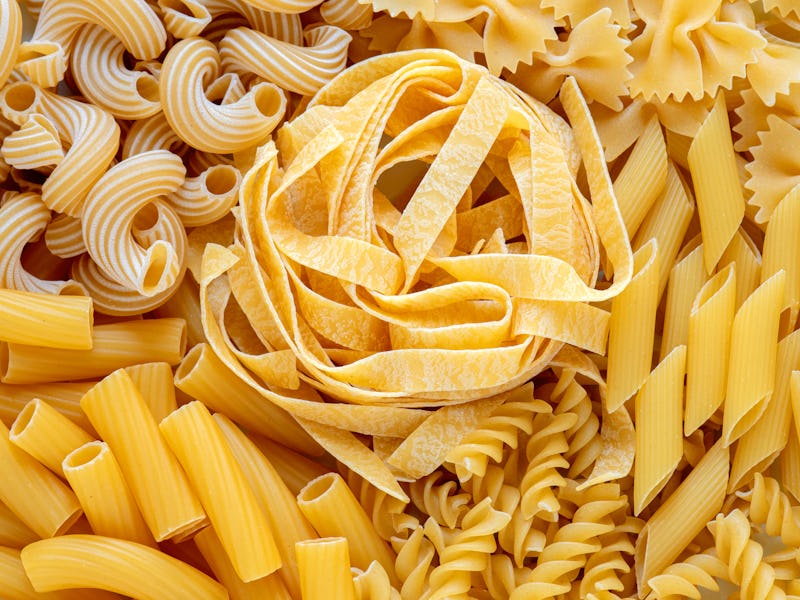Molecular chemistry debunks a misguided pasta cooking technique
Salted water is all you need.

If you boil your pasta with oil, stop. Right now. Seriously.
Perhaps you came across a cookbook or site that offered the advice to pour some olive or canola oil into the pot of boiling water that is cooking your rigatoni. Maybe you have a family member who swears by this method, claiming it keeps the water from boiling over and the pasta from sticking together.
Adding olive oil to a simmering pan of tomatoes can do your sauce a lot of good, but adding oil to boiling water can seriously mess with your spaghetti. If you don’t trust me, trust chef and restauranteur Lidia Bastianich, who reportedly said, “Do not — I repeat, do not — add oil to your pasta cooking water! And that’s an order!” And if you don’t trust either of us, here’s the science.
Does adding oil to pasta water work?
The idea behind oil keeping the water from boiling over the pot stems from the fact that, since oil and water don’t mix, the oil will coat the top and prevent anything from spilling out. Let’s unpack that.
First of all, why does water sometimes boil over when you are cooking pasta? Well, part of the answer is just that by adding pasta into the pot, you are leaving less room for the water. The other part has to do with surface tension.
Water molecules have a positively charged end and a negatively charged end. Opposites attract, and so water’s composition creates an invisible net of molecules lined up end to end. This net makes it more difficult for objects to break through the surface, which is why some materials can float without falling through. When it comes to boiling, water itself doesn’t foam when heated because the surface tension created by the invisible net keeps bubbles from breaking through.
It’s only when pasta, which contains proteins, gluten, and other organic substances, mixes with the water molecules. Some components of the pasta dissolve while others don’t. The parts that dissolve, which are described as polar, gather on the surface and mesh with the molecules; the non-water-soluble parts, described as hydrocarbon, stick straight up. These components disrupt the tight, invisible net that water molecules create, which leaves more room for the surface to expand into bubbles — and, of course, spillover.
But when you add oil, things change. Oil won’t mix with water. It visibly disperses into smaller droplets throughout the liquid. Droplets at the surface interfere with bubbles forming. When a foam bubble starts to form, it comes in contact with an oil droplet. The sheer difference in surface tension of water versus oil makes the bubble pop, preventing water from foaming over at the surface.
The idea behind oil keeping the water from boiling over the pot stems from the fact that, since oil and water don’t mix, the oil will coat the top and prevent anything from spilling out.
So why shouldn’t I do it?
Even though oil does interrupt water’s surface tension, it can prevent the sauce from properly sticking to and coating pasta. While oil does coat the water’s surface, that means that when the pasta’s drained, it passes through the oily top layer.
Rest assured that the same effect doesn’t come with oil-based sauces. Add olive oil to tomato sauce all you want.
And if you want to keep the pot from boiling over, you have a few options. You can stand watch and give the pot a stir every time it looks like it’s about to boil over, you can cook the pasta without a lid, or you can prop the lid open with a wooden spoon to release the steam that’s building up.
How can I cook pasta better?
Give the boiling water a good salt. While it’s true that salt can lower the boiling point of water, theoretically making your pasta water boil sooner, the amount of salt that would do the trick would also likely be too much for your palate. But, a generous pinch of salt will flavor the water and your pasta.
Save pasta water and add it as needed to sauces. The starchy water will help sauces better coat the pasta, and will also thicken the sauce.
Don’t rinse pasta after draining it; that will also rinse away the surface starches that help other substances coat and stick to it.
Drain the pasta several minutes before it reaches al dente. Then, toss it in a heated pan with your sauce of choice so that it finishes cooking while bathed in flavor.
And if you don’t trust Lidia Bastianich? Trust actual pasta brand Barilla, who just wants you to have the best plate of pasta possible.
CHECK, PLEASE is an Inverse series that uses biology, chemistry, and physics to debunk the biggest food myths and assumptions.
Now read this: Is dark chocolate good for your heart? A physician reveals the unfortunate truth
This article was originally published on